Lois McCarty, Spring, TX
As teachers we share many ideas. Many times we tweak them and combine them to meet the needs of our students. I would like to share one twist and combination that can be used for closure and review for a lesson or for a chapter.

The strategy uses a modified carousel where the problem or task is passed from person to person on a team. To reinforce vocabulary, the task would be to complete a Frayer Model for a vocabulary word from the lesson or from the chapter. Each team member would fill in something in one section of the sheet (the definition, characteristics or facts, example or non-example) and then pass the paper to the next team member to enter information in another section of the model. A second pass through would allow students to add attributes to each section or to explain their contribution to the model.
To emphasize or review more vocabulary words, each team member could start with a different word, fill out one part of the Frayer Model, and then pass it onto the next team member. When finished, each team member should review or read the completed model and discuss any modifications. These completed Frayer Models could then be included in an interactive notebook or in the classroom Word Wall.

